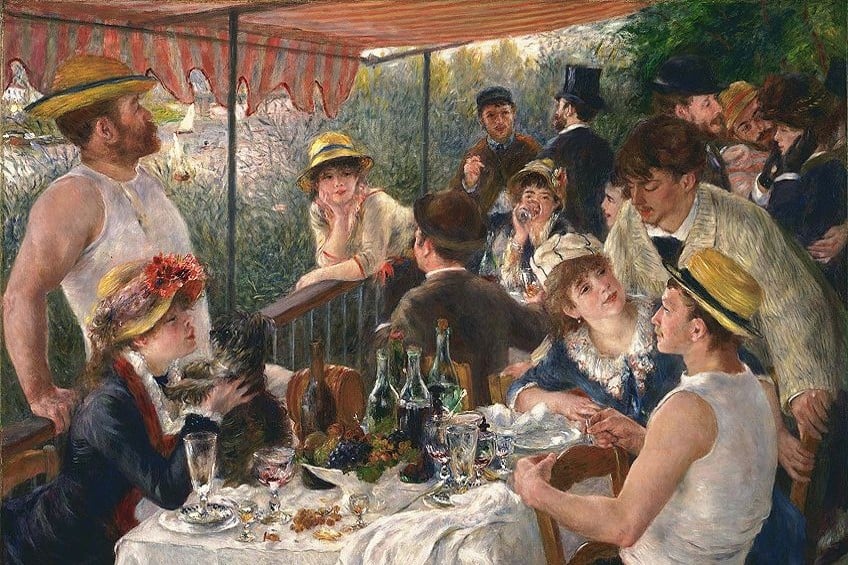Famous Impressionist Paintings – The Best Impressionism Art
Impressionism is considered one of the most influential art movements in art history. The art style emerged as the French Impressionist movement, which was first founded in Paris during the 19th century and has since opened the floodgates to introduce other movements such as Fauvism, Cubism, post-Impressionism, and more importantly, Modernism. This article will introduce you to the top 15 most famous Impressionism paintings in art history.
Impressionism: Origins
Impressionism has its roots in mid-19th-century Paris and emerged as a result of dissatisfied artists who rejected the ideals of the academy. The most famous Impressionist paintings are also the first few Impressional artworks that caused quite the scandal back in the day for the reserved art critic and Salon jury member.
The ideals of the academy revolved around the representation of real-world, historical, religious, and mythological subjects in a realistic and technically correct manner (proportion, color, and subject matter).
On the other hand, Impressionist art revolved around landscapes, contemporary subject matter, visible brush strokes, and other scenes expressing pleasure, entertainment, and in-between moments of daily life. One can say that everyday life was romanticized by Impressionism.

Impressionist art first relied on the depiction of color about light in a way that would capture the scene as it appeared to the artist’s subjective account. Impressionism later expanded when each member of the group (and others influenced by the original style) chose to diverge away from the idea of classification and explore their styles, which paved the way for other art movements such as Fauvism, Cubism, Neo-Impressionism, post-Impressionism, and Modernism.
The group of artists who rejected the traditional preferences were known as the Impressionists and included artists such as Camille Pissarro, Claude Monet, Edgar Degas, Mary Cassatt, Alfred Sisley, and many others.
The group eventually formed its society and hosted a total of eight Impressionist exhibitions. Although the rise of Impressionism had a great start in France, it did have its influence across the world and can be seen in the works of British artists such as Wilson Steer and Walter Sickert.
Top 16 Famous Impressionist Paintings
Towards the later stages of the group’s operations, many artists chose to pursue their unique styles and preferences to advance their careers and this marked the birth of an individualistic approach to art and the development of different art styles, all that can now be admired and accepted as compared to the 19-century art critics who often referred to Impressionist paintings as grotesque, vulgar, and unfinished. Below, we will take a look at the top 16 most famous paintings from the Impressional art period in art history, starting with a few early pieces that caught the attention of these conservative critics.
Le Dejeuner sur l’Herbe (1863) by Édouard Manet
| Artist | Édouard Manet (1832 – 1883) |
| Date | 1863 |
| Medium | Oil on canvas |
| Dimensions (cm) | 208 x 264.5 |
| Where It Is Housed | Musée d’Orsay, Paris, France |
Édouard Manet brought much shock to the Salon after presenting the famous Le Déjeuner sur l’Herbe (“Luncheon on the Grass”) in 1863, before his next best painting, Olympia (1863). While many critics commented on his painting as being too vulgar, the painting was received well by artists such as Émile Zola who said “It is…a vast assemblage, full of atmosphere, a corner of nature represented with admirable simplicity”.
Le Déjeuner sur l’Herbe depicts a picnic scene with a naked woman in the company of two fully clothed men.

The presence of a female nude in this scene makes the painting contemporary and almost tends toward the first representations of modernity. As in Olympia, the naked woman is also gazing directly at the viewer suggesting her unapologetic nature and comfort with her body being exposed to nature and the eyes of the viewer.
Olympia (1863) by Édouard Manet
| Artist | Édouard Manet (1832 – 1883) |
| Date | 1863 |
| Medium | Oil on canvas |
| Dimensions (cm) | 190 x 130 |
| Where It Is Housed | Musée d’Orsay, Paris, France |
Among Édouard Manet’s many “scandalous” paintings presented for the Salon, Olympia (1863) was particularly disgraceful for the 19th-century art critic since the woman portrayed is said to promote an unashamed demonstration of sexuality and pride, which you can imagine, was a complete desecration of a female nude.
Manet stowed away the painting for approximately 18 months after finishing it to later present it at the Salon.
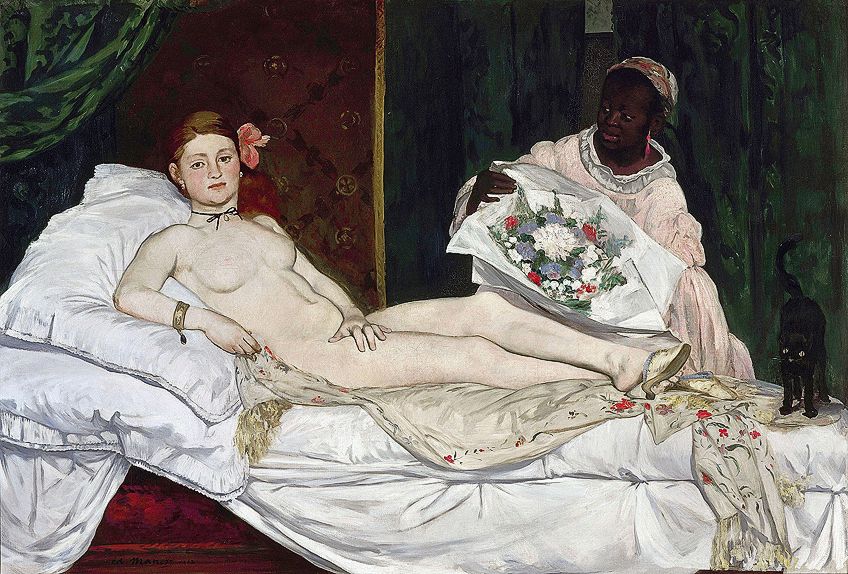
The Parisian woman is said to be a prostitute who can be seen receiving a gift, a bouquet, which was probably from an admirer or client. Manet also received criticism for his technique regarding the broad brush strokes. More so than anything, it was Olympia’s direct and unapologetic gaze indicating an awareness of her position and comfortable, almost incredibly modern position and display of modernity that stirred the viewers.
Manet was initially excited to have his painting at the Salon but soon after its exhibition, he received a huge influx of harsh criticism, which caused him to take a trip to Spain instead, as any artist under such commentary would.
Some of the harsher comments include Olympia being described as a “female gorilla” and “a corpse at an advanced stage of decomposition”. You can only imagine the spectacle that ensued upon its release and the impact that it had on the artist’s mental health.
Impression, Sunrise (1872) by Claude Monet
| Artist | Claude Monet (1840 – 1926) |
| Date | 1872 |
| Medium | Oil on canvas |
| Dimensions (cm) | 50 x 65 |
| Where It Is Housed | Musée Marmottan Monet, Paris, France |
Impression, Soleil Levant (1872), or “Impression, Sunrise” in English, was the first painting by Claude Monet, who is considered the leader of the Impressionists, that sparked critics to deem the style of the painting as an impression and, hence, the term Impressionism was born. The painting depicts the artist’s view of a sunrise from the port of Le Havre, painted in a stunning array of cool-toned colors, contrasted by the glistening orange sun.
Criticized as being unfinished and worse than the wallpaper, the painting was executed in a few hours and featured in the group’s first Impressionist exhibition in 1874.

Many of Monet’s paintings paved the way for the defining characteristics of Impressionist art, characterized by the “unfinished”, smudged, and blurry representation. Monet extensively worked on the representation of light in different seasons and loved to paint light about water.
His other famous Impressionist painting series of water lilies from his personal garden was also worked on during the last 30 years of his life. Monet was truly dedicated to Impressionism and what it initially stood for.
Upon its emergence, Impressionism was defined by landscape painting executed en Plein air meaning that the process of painting was done without any preparatory sketches, precise measurements, or set deadlines. The painting was done at the scene and intended to capture the moment as the artist saw it. Early French Impressionist artworks relied upon light and the way that they altered the traditional representation of color as witnessed through the artist’s eyes.
Le Pont de Villeneuve-la-Garenne (1872) by Alfred Sisley
| Artist | Alfred Sisley (1839 – 1899) |
| Date | 1872 |
| Medium | Oil on canvas |
| Dimensions (cm) | 49.5 x 65.4 |
| Where It Is Housed | The Metropolitan Museum of Art, New York, United States |
Initially, Alfred Sisley attempted to pursue a career in business but soon found his footing at the Paris École des Beaux-Arts. Bridge at Villeneuve-la-Garenne (1872) is one of Sisley’s most famous paintings depicting a symbol of modernity, a recently constructed bridge painted with a dramatic angle highlighting the stone and cast-iron suspension bridge built in 1844.
The bridge was built to connect Villeneuve-la-Garenne (a village) with Saint-Denis, a Parisian suburb.
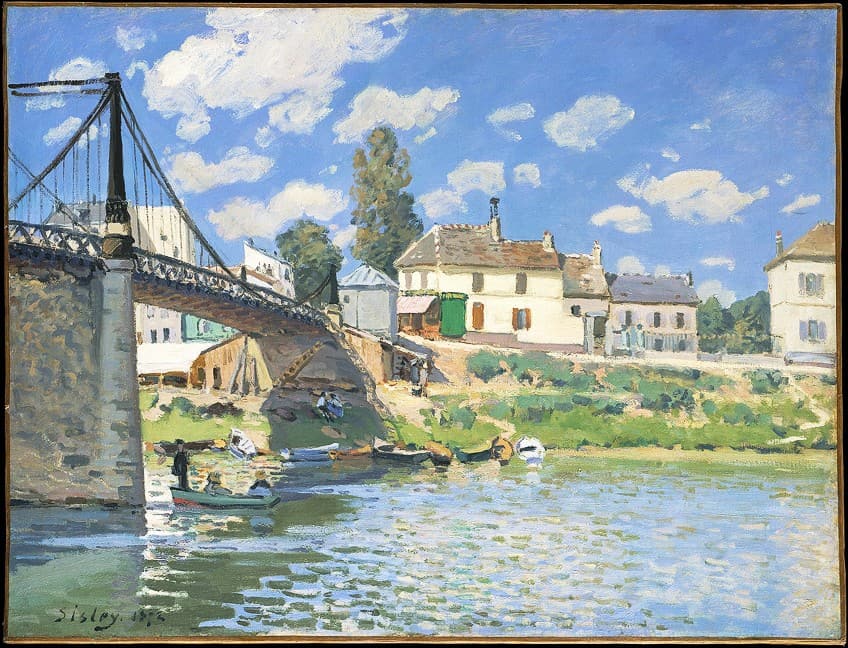
In the painting, Sisley also included a few holidaymakers on the Seine River and drew attention to the water by using flat brush strokes with contrasting colors to demonstrate the reflection of the light on the surface of the river. Many of Sisley’s paintings depict bridges well into the 1880s and solidify one of the main intentions of Impressionism, that is, to strive toward modernity.
The Cradle (1872) by Berthe Morisot
| Artist | Berthe Morisot (1841 – 1895) |
| Date | 1872 |
| Medium | Oil on canvas |
| Dimensions (cm) | 56 x 46 |
| Where It Is Housed | Musée d’Orsay, Paris, France |
The Cradle (1872) is one of the most famous Impressionist paintings by one of the best 19th-century female painters, Berthe Morisot, who alongside other underappreciated women artists during the Impressionist era such as Lilla Cabot Perry, Eva Gonzalès, Mary Cassatt, and Marie Bracquemond, left an impact on the realm of French Impressionist painting.
The painting illustrates the artist’s sister, Edma, who is seen watching over the cradle of her baby Blanche and represents one of Morisot’s favorite subjects, motherhood.

The subject of motherhood is seen not only in the subjects but in the gaze of Edma and her body language toward the child. Morisot depicts Edma bending her left arm as a mirror image of the child’s arm. The baby’s eyes appear closed and this forms a diagonal line that is complimented by the curtain in the backdrop. The diagonal line connects the mother to the baby and the gesture of Edma drawing the curtain net between the baby and the viewer further solidifies the feeling of intimacy and protection expressed by a mother.
The Cradle was first shown in the 1874 Impressionist exhibition, which was even more so important since Morisot was the first female artist to exhibit in the group at the time.
Many critics praised her work for its display of elegance but it did not receive as much attention as the spectacles of her contemporaries. The painting was unsuccessful in its sale and so it remained with Morisot’s family until its purchase in 1930 by the Louvre Museum.
Poppies (1873) by Claude Monet
| Artist | Claude Monet (1840 – 1926) |
| Date | 1873 |
| Medium | Oil on canvas |
| Dimensions (cm) | 65 x 50 |
| Where It Is Housed | Musée d’Orsay, Paris, France |
This iconic image of a poppy field by Monet is one of the most famous Impressionism artworks ever created. Monet moved to Argenteuil where he painted many iconic scenes that served as a period of fulfillment. The magnificent landscapes of Argenteuil allowed him to develop his painting style while practicing the en Plein air technique.
Poppies (1873) was first shown at the inaugural exhibition of the Impressionists in 1874 and has since become one of the world’s most recognizable Impressionist artworks.
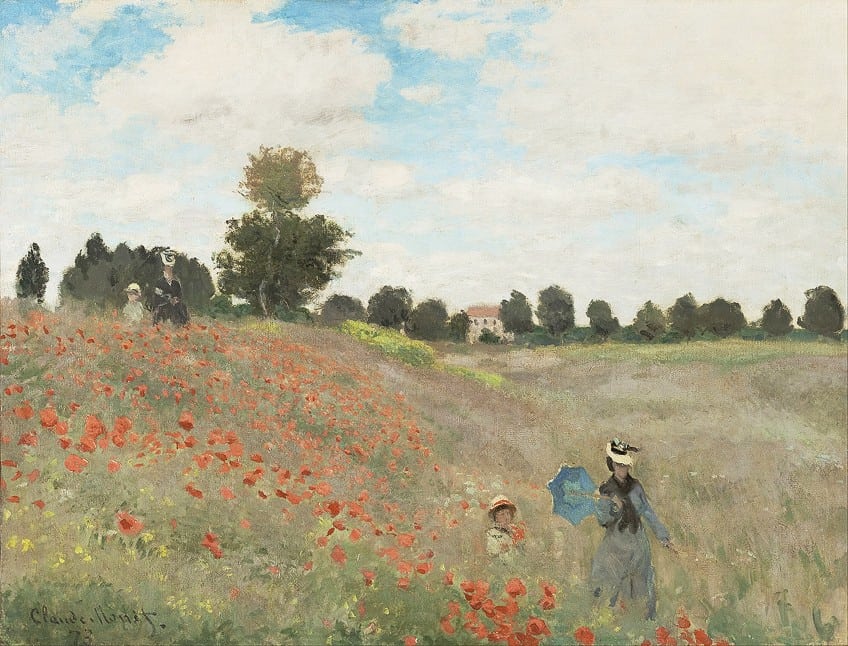
The painting resurrects the moment in which Money witnessed his wife and child strolling through the field and is quite a beautiful intimate family moment, considering his wife’s declining health. The most wonderful aspect of the painting lies in the stippled red dots of poppies contrasted by the subdued hues of the vegetation in the field. It can be said that Monet had taken the first leap toward abstraction since his paintings became less detailed and blurrier.
Among Monet’s other famous works include his water lilies series and sailing boat paintings.
In a Café (1873) by Edgar Degas
| Artist | Edgar Degas (1834 – 1917) |
| Date | 1873 |
| Medium | Oil on canvas |
| Dimensions (cm) | 68 x 92 |
| Where It Is Housed | Musée d’Orsay, Paris, France |
While Edgar Degas may have been strongly drawn to dancing and theatrical performance, he was ultimately an urban painter. Depicted in In a Café (1873) is a woman consuming a dangerous alcoholic drink called absinthe, which was later banned.
Degas had caused some harm to the reputation of the models he used as he employed people that he knew and the painting attracted slurs towards the characters from the public.
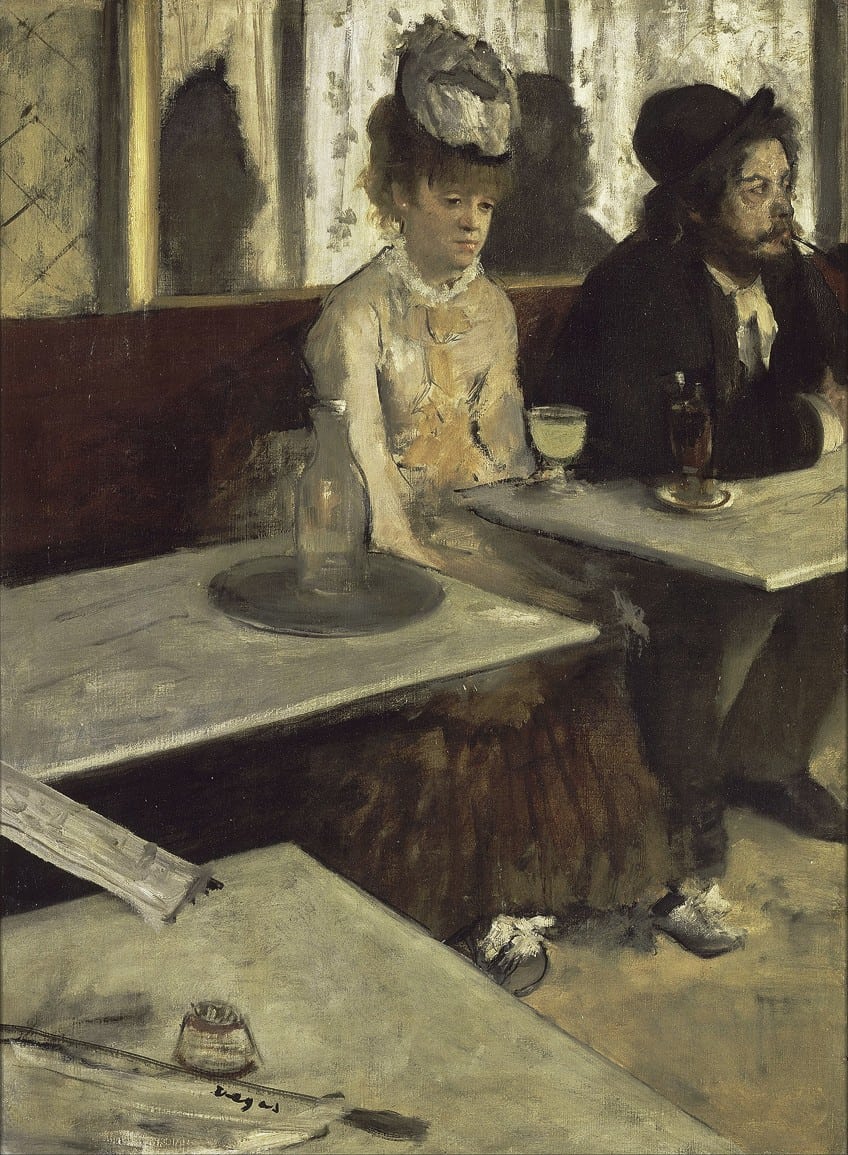
This so-called impressionist painting is also deceptive since it was not executed at the exact setting portrayed in the scene but was created in Degas’ studio. The café was meant to be a pleasant area for communion and enjoyment but Degas overturned the general view and demonstrates an environment of silent desolation, addiction, and detachment.
The Dance Class (1874) by Edgar Degas
| Artist | Edgar Degas (1834 – 1917) |
| Date | 1874 |
| Medium | Oil on canvas |
| Dimensions (cm) | 83.5 x 77.2 |
| Where It Is Housed | The Metropolitan Museum of Art, New York, United States |
The works of Edgar Degas appear to contain many elements of Impressionist art but Degas himself did not consider himself to be an Impressionist. Degas was more interested in historical painting and traditional subject matter. Later in his life, he took interest in scenes from concerts and specifically ballerinas and dancers. The highlight of his paintings were the background scenes in the lives of the dancers.
Degas enjoyed studying rehearsals and the movements of the body associated with dancing.
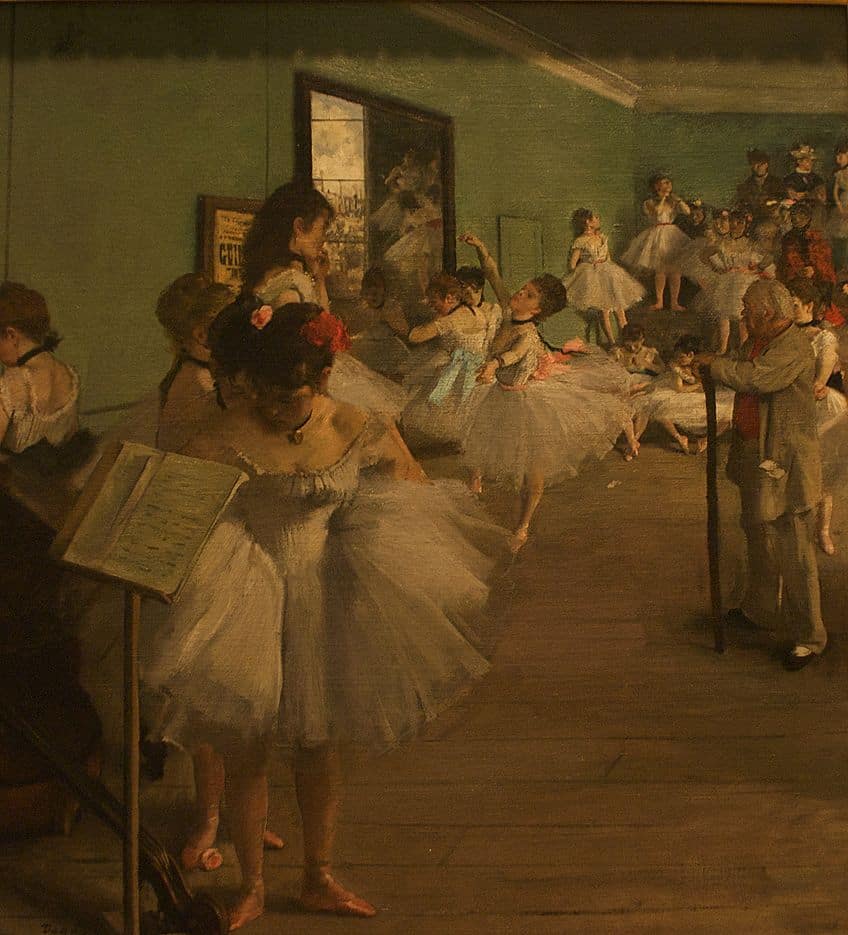
It was the professional lives of the young dancers that he chose to illustrate in his mastery over the use of pastel colors. In The Dance Class (1874), Degas showcases the instructor positioned in the center towards the right-hand side supervising the dancers.
Degas excellent mastery over perspective also makes the practice studio seem incredibly long and really sets the scene for the viewer.
La Loge (1874) by Pierre-Auguste Renoir
| Artist | Pierre-Auguste Renoir (1841 – 1919) |
| Date | 1874 |
| Medium | Oil on canvas |
| Dimensions (cm) | 80 x 63.5 |
| Where It Is Housed | Courtauld Institute of Art, London, United Kingdom |
La Loge (1874), translating to “The Theater Box” in English, refers to a famous Impressionist painting by Pierre-Auguste Renoir that is said to be his first masterpiece. La Loge illustrates the couple at the theater in Paris. The woman is said to have been modeled by Nini Lopez, who was a muse for Renoir and featured in 14 other paintings.
The man in the painting is Renoir’s brother, Edmond, who was also an art critic and a journalist.

A trip to the theater meant that you not only attended to view the show, but it was also an opportunity to be seen. The painting was featured in the Impressionist’s first group show in 1874, which received mixed reactions. Although the painting did not sell immediately, it was purchased the following year by a dealer named Père’ Martin for 425 francs.
Renoir later left the Impressionists to pursue his preferred style of a classical approach.
Paris Street: Rainy Day (1877) by Gustave Caillebotte
| Artist | Gustave Caillebotte (1848 – 1894) |
| Date | 1877 |
| Medium | Oil on canvas |
| Dimensions (m) | 2.12 x 2.76 |
| Where It Is Housed | School of the Art Institute of Chicago, Chicago, United States |
This massive oil painting by Gustave Caillebotte is an incredibly famous painting executed in 1877 and is known to be a foundational image for other Impressionism artworks. The painting was created using a multipoint perspective technique to illustrate the various views and angles of people traveling through the Place de Dublin, which was previously identified as the Carrefour de Moscou in northern Paris.
Caillebotte was friends with many of the French Impressionists but his painting style stood out as it differed in the presentation of Realism and perspective rather than prominent brush strokes.
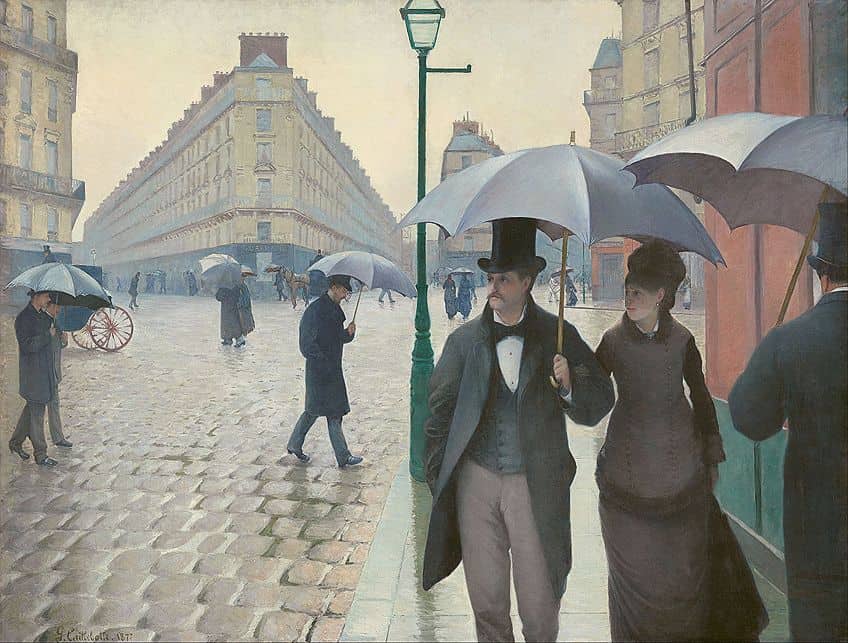
Paris Street: Rainy Day (1877) also featured in a 1980 television series broadcasted on the BBC called 100 Great Paintings as well in the movie Ferris Bueller’s Day Off, which aired in 1986. Caillebotte was also interested in photography and as one can imagine, Impressionism also faced the introduction of photography, an easier method of capturing moments, as a threat. Photography as an art form for inspiration shows up in Caillebotte’s paintings through his use of perspective and angles, as if showing the viewer snapshots of scenes that would otherwise also be rendered using a camera.
Unfortunately, Caillebotte died at the early age of 45 while working in his garden but he did leave behind some of the most iconic Impressionist paintings.
Luncheon of the Boating Party (c. 1880 – 1881) by Pierre-Auguste Renoir
| Artist | Pierre-Auguste Renoir (1841 – 1919) |
| Date | 1880 – 1881 |
| Medium | Oil on canvas |
| Dimensions (cm) | 175.5 x 130.1 |
| Where It Is Housed | The Phillips Collection, Washington, D.C., United States |
The Phillips Collection houses one of Renoir’s most famous Impressionist paintings, Luncheon of the Boating Party (1880 – 1881), which garnered many comments and admirers. The painting showcases all of Renoir’s friends, including Gustave Caillebotte who is seen seated in a chair staring at Renoir’s soon-to-be wife, Aline Charigot, seated across the table.
Renoir beautifully employed his Impressionist skills to immortalize his friends and capture an intimate, joyful memory.

Renoir also blends various compositions such as figure painting, landscape, and still life into one frame. The painting gained such a great reputation that it was also regarded as one of the most famous French paintings portraying modern times.
Rainy Day, Boston (1885) by Childe Hassam
| Artist | Frederick Childe Hassam (1859 – 1935) |
| Date | 1885 |
| Medium | Oil on canvas |
| Dimensions (cm) | 66.3 x 122 |
| Where It Is Housed | Toledo Museum of Art, Toledo, Ohio, United States |
Recognized as one of the greatest American Impressionists, Childe Hassam was famous for his coastal and urban scenes. Throughout his career, he produced more than 3000 paintings and was extremely influential up until the 20th century.
Although starting off with very little formal training in art, Childe began his endeavors as an illustrator and later joined a trip to Europe with his friend Edmond Garrett for two months, where he explored watercolors.

In the 1880s, Childe started painting cityscapes like the one seen above in Rainy Day, Boston (1885). Rainy Day, Boston also displays a similar composition and aesthetic to that of Gustave Caillebotte’s Paris Street: Rainy Day (1877), which makes use of a multipoint perspective to showcase the different angles of the streets.
Girl Arranging Her Hair (1886) by Mary Cassatt
| Artist | Mary Cassatt (1844 – 1926) |
| Date | 1886 |
| Medium | Oil on canvas |
| Dimensions (cm) | 75.1 x 62.5 |
| Where It Is Housed | National Gallery of Art, Washington, D.C., United States |
Mary Stevenson Cassatt was one of the most famous American Impressionists who also befriended Edgar Degas, forming a lifelong friendship with him. Cassatt was already a prominent figure before joining the Impressionists and was known for her strong rejection of the Salon and what it stood for regarding how female artists would be allowed to exhibit.
Mary Cassatt also worked alongside other artists like Berth Morisot and Marie Bracquemond, who shared similar beliefs.
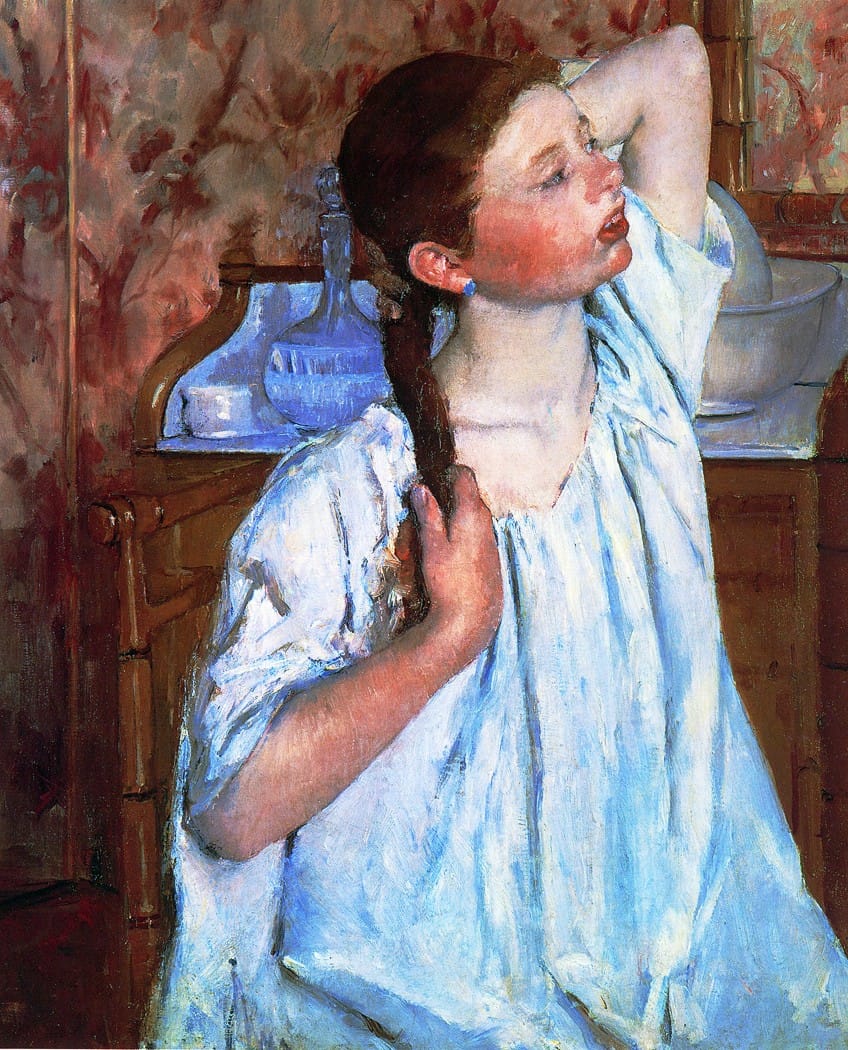
Girl Arranging her Hair (1886) is a famous example of Cassatt’s adaptation of Impressionism in painting, alongside her other recognized painting In the Loge (1878). Her painting was so exquisite in technique and use of color that people even mistook it to be the work of Edgar Degas.
Mary Cassatt is a prime example of women in Impressionism and her perseverance despite the male-dominated group is something to be admired.
Girl with Peaches. Portrait of V.S. Mamontova (1887) by Valentin Serov
| Artist | Valentin Alexandrovich Serov (1865 – 1911) |
| Date | 1887 |
| Medium | Oil on canvas |
| Dimensions (cm) | 91 x 85 |
| Where It Is Housed | The State Tretyakov Gallery, Moscow, Russia |
Known as the masterpiece of Russian painting, Girl with Peaches (1887) was created by the Russian artist Valentin Serov and is considered to be one of his best works. Valentin Serov was the son of a well-known music composer and critic called Alexander Serov and another composer, the artist’s mother, Valentina Serova, who provided much artistic stimulation for Serov from an early age. Serov was also affiliated with the famous Russian magazine and art association called The World of Art.
The figure in the painting is the daughter of a Russian patron named Vera Mamontova, who Serov knew very well.

According to Serov, he needed a “special freshness” to his painting that would not otherwise be felt in a painting and chose the young girl to serve as the symbol of that fresh and youthful quality. In the artist’s later years, he moved on to paint more classical and mythological themes embedded with his interpretation.
The painting had also become a Russian internet meme where the sitter is taken out of context and placed into humorous scenes.
In the same year, the painting won first place at the Moscow Society of Lovers of Art exhibition. Serov was greatly acknowledged as a pioneer of Russian Realism and even had a small planet named after him called 3547 Serov, which was discovered in 1978 by the Soviet astronomer Lyudmila Vaisilyevna Zhuravlyova.
The Card Players (1890 – 1892) by Paul Cézanne
| Artist | Paul Cézanne (1839 – 1906) |
| Date | c. 1890 – 1892 |
| Medium | Oil on canvas |
| Dimensions (cm) | 65.4 x 81.9 |
| Where It Is Housed | The Metropolitan Museum of Art, New York, United States |
Forming part of a series of five paintings, The Card Players (1890) by Paul Cézanne is incredibly famous since it comes from a series that sold for approximately $259 million in 2011. Cézanne was known to be a disturbed young man who did not have the best relationship with his father and even started painting images of murder scenes.
Cézanne was inducted into the group of Impressionists by Camille Pissarro, who was regarded as the father figure of the Impressionist group.
Cézanne seemed to have an addictive tendency and at some point, he became so enmeshed in his work that he became estranged from his best friend and his family. The Card Players portrays a group of men focusing all their energy on the game of cards. Two paintings from the series depict a group with three players while the other three paintings only show a duo. Cézanne’s Card Players is attractive for many qualities, including the odd proportion and the detached nature of the players about each other.
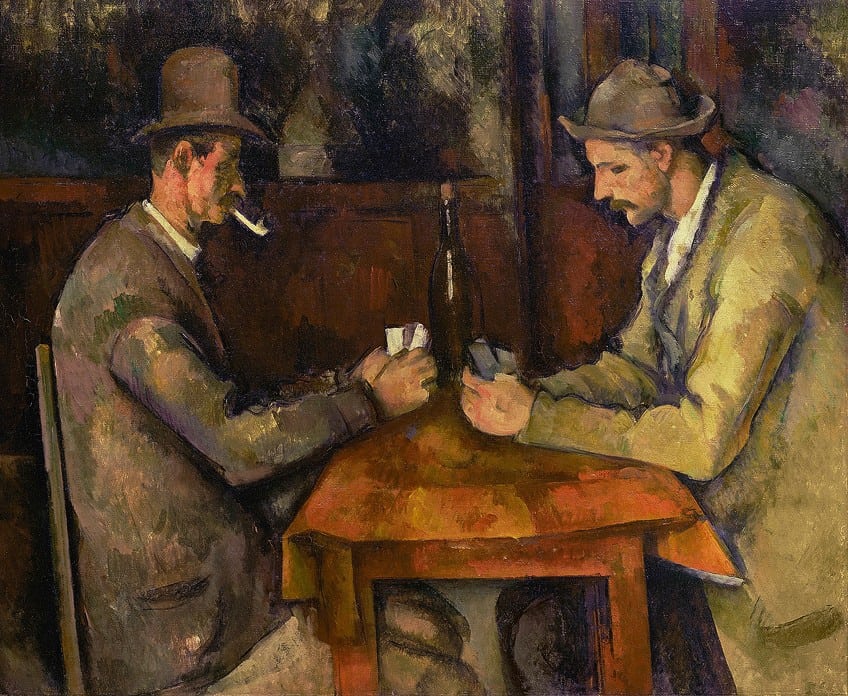
The series also contains objects such as pipes and hats since the artist’s father owned a hat shop before becoming a banker and this seemed like a great influential period for the young Cézanne. The color blue is also a significant element in the series and is present in four out of the five paintings.
Perhaps this was the mood associated with the scene that Cézanne imagined or recalled.
Like Cézanne’s Card Player series, other Impressionist paintings also fall on the list of some of the world’s most expensive artworks, which just goes to show the value at which Impressionist art is placed today. Back in 19th-century Paris, Impressionist art was seen as a joke but today many Impressionist works sell for millions.
Le Boulevard Montmartre, Effet de Nuit (1897) by Camille Pissarro
| Artist | Camille Pissarro (1830 – 1903) |
| Date | 1897 |
| Medium | Oil on canvas |
| Dimensions (cm) | 53.3 x 64.8 |
| Where It Is Housed | The National Gallery, London, United Kingdom |
Camille Pissarro was not only considered by his close contemporaries as the father figure of the Impressionists, but he was also the dean of the group and a key proponent of Neo-Impressionism. Pissarro was the only one who held onto the original ideals of Impressionism until the end. His work revolved around landscapes and cityscapes of Paris in the evening.
The Danish-French Impressionist was also considered to be a master painter by Paul Gauguin and had left behind a major influential legacy for the other post-Impressionists.
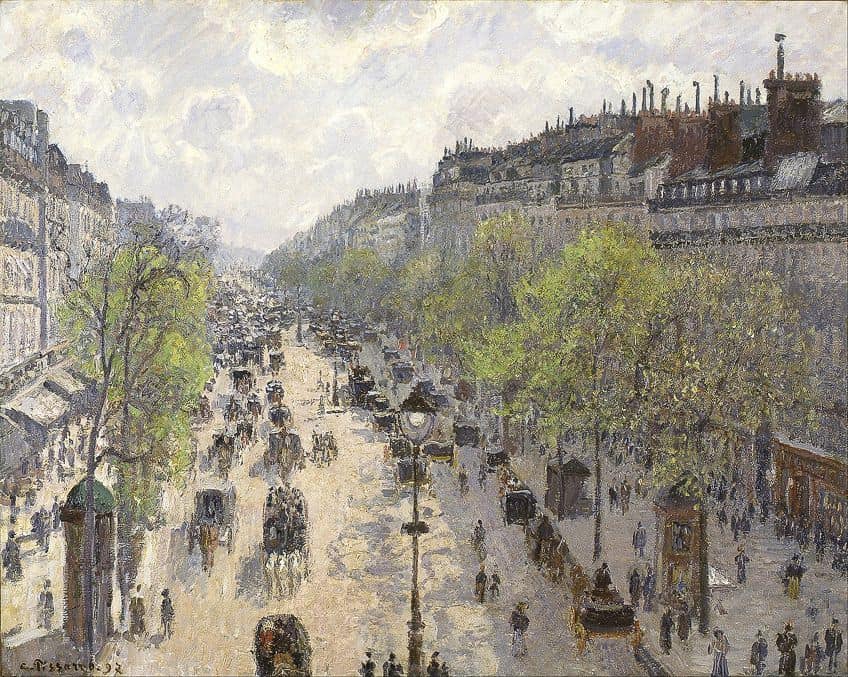
Pissarro also made use of a technique called Pointillism, which encompassed the grouping of tiny dots arranged in different patterns to create the optical illusion of colors that appear blended from afar. Le Boulevard Montmartre, effet de nuit (“Boulevard Montmartre, night effect”) was painted in 1897 but was never exhibited to the public during the artist’s lifetime.
The Importance of Impressionism Art
You may wonder why Impression artworks are so important and why so many famous paintings, in general, are derived from this movement. The answer to the significance of this art movement lies in recognizing that the movement started as a rejection of the former, outdated approach to painting, which was seen as quite narrow and somewhat harmful to exploring creativity itself.
The Impressionists allowed for the acceptance of other styles of painting, which can be thought of as a breakthrough in thinking about what art could be and how far one could expand the current confines of 19th-century academic expectations.
Although the original Impressionist group broke off and went their separate ways, the divergence allowed each artist to develop their signature style and expand art history in different movements as we understand it today. It is important to acknowledge that the Impressionists also paved the way for the emergence of Modernism.

Other famous Impressionist paintings include The Floor Scrapers (1875) by Gustave Caillebotte, Bal du moulin de la Galette (1876) by Pierre-Auguste Renoir, Woman Reading (1879) by Édouard Manet, A Bar at the Folies Bergere (1882), Young Woman Sewing in a Garden (1886) by Mary Cassatt, The Large Bathers (1898 – 1905) by Paul Cézanne, Water Lily Pond (1899) by Claude Monet, and The Yellow Christ (1899) by Paul Gauguin.
Many of the Impressionist painters were either influenced by each other or acquainted with each other in some way. The paintings found in Impressionism art can be thought of as a solution and a communion of artists coming together to initiate their own justice on the ideals of the Salon and the notion of art and subject matter of 19th-century Western art itself.
Take a look at our Impressionist art webstory here!
Frequently Asked Questions
What Is Impressionism?
Impressionism refers to the 19th-century art movement that was initiated by a group of artists, also referred to as the French Impressionists, who came together to focus on their style of painting defined by en Plein air to capture the subject or scene in the moment of the artist experiencing the scene. Impressionism focused on landscapes and experimentation with the depiction of light and color.
Who Are the Most Famous Impressionist Painters?
The most famous Impressionist painters are considered to be Claude Monet, Camille Pissarro, Édouard Manet, Mary Cassatt, Edgar Degas, Alfred Sisley, Gustave Caillebotte, and many others from the original group of Impressionists.
What Is the Most Expensive Impression Artwork?
The most expensive Impression artwork is a painting by Paul Cézanne called Card Players (1890 – 1892), which is part of a series and was last valued at around $340 million in 2020. Cézanne’s painting is followed by Renoir’s Moulin de la Galette (1876), which was estimated to be worth $143 million in 2021.
Jordan Anthony is a Cape Town-based film photographer, curator, and arts writer. She holds a Bachelor of Art in Fine Arts from the University of the Witwatersrand, Johannesburg, where she explored themes like healing, identity, dreams, and intuitive creation in her Contemporary art practice. Jordan has collaborated with various local art institutions, including the KZNSA Gallery in Durban, the Turbine Art Fair, and the Wits Art Museum. Her photography focuses on abstract color manipulations, portraiture, candid shots, and urban landscapes. She’s intrigued by philosophy, memory, and esotericism, drawing inspiration from Surrealism, Fluxus, and ancient civilizations, as well as childhood influences and found objects. Jordan is working for artfilemagazine since 2022 and writes blog posts about art history and photography.
Learn more about Jordan Anthony and about us.
Cite this Article
Jordan, Anthony, “Famous Impressionist Paintings – The Best Impressionism Art.” artfilemagazine – Your Online Art Source. October 18, 2022. URL: https://artfilemagazine.com/famous-impressionist-paintings/
Anthony, J. (2022, 18 October). Famous Impressionist Paintings – The Best Impressionism Art. artfilemagazine – Your Online Art Source. https://artfilemagazine.com/famous-impressionist-paintings/
Anthony, Jordan. “Famous Impressionist Paintings – The Best Impressionism Art.” artfilemagazine – Your Online Art Source, October 18, 2022. https://artfilemagazine.com/famous-impressionist-paintings/.


